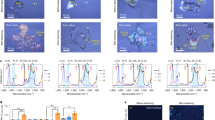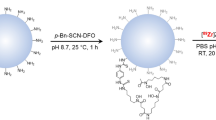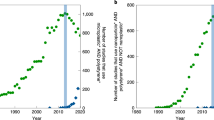Abstract
Micro- and nanoplastic particles are ubiquitous environmental pollutants, threatening human health, aquatic and soil ecosystems. These minute synthetic fragments, persisting for centuries, infiltrate the food chain, posing potential health risks through bioaccumulation in various tissues, toxicity and exposure to associated chemicals. Although macro- and microplastics are intensively examined in environmental and biological research, information on nanoplastics with diameters below 1 μm is limited. Such particles can cross biological borders, including the blood–brain barrier, posing a greater health risk than microplastics. Apart from the mere detection of such particles, gaining an understanding of size distribution, numbers and size limits will be crucial in assessing their impact on global ecosystems and human health. Here we establish an optical sieve that uses Mie void resonances for nanoplastic detection and sizing. The optical sieve consists of arrays of optically resonant voids with different diameters that simultaneously serve as filtering and sorting elements, as well as all-optical reporters, requiring only an optical microscope and a standard camera with an RGB sensor in combination with colorimetric analysis. The system is evaluated using a synthesized real-world sample with a plastic particle mass concentration of 150 μg ml−1. Our approach consequently delivers statistical information on numbers, size and size distribution via the observation of distinct colour changes, overcoming the need for advanced techniques such as scanning electron microscopy. The proposed method offers a straightforward, highly accessible and mobile solution, making it an efficient and easily implemented tool for environmental and biological research.
This is a preview of subscription content, access via your institution
Access options
Access Nature and 54 other Nature Portfolio journals
Get Nature+, our best-value online-access subscription
$32.99 / 30 days
cancel any time
Subscribe to this journal
Receive 12 print issues and online access
$259.00 per year
only $21.58 per issue
Buy this article
- Purchase on SpringerLink
- Instant access to full article PDF
Prices may be subject to local taxes which are calculated during checkout





Similar content being viewed by others
Data availability
Further experimental and simulated data are available from the corresponding author on reasonable request. Source Data are provided within this paper
Code availability
The numerical simulation code and colour readout code are available from the corresponding author on reasonable request.
References
Nanoplastic should be better understood. Nat. Nanotechnol. 14, 299 (2019).
Andrady, A. L. The plastic in microplastics: a review. Mar. Pollut. Bull. 119, 12–22 (2017).
Fusco, L. et al. Nanoplastics: immune impact, detection, and internalization after human blood exposure by single-cell mass cytometry. Adv. Mater. 37, 2413413 (2024).
Carpenter, E. J. & Smith, K. L. Jr. Plastics on the Sargasso sea surface. Science 175, 1240–1241 (1972).
Carpenter, E. J., Anderson, S. J., Harvey, G. R., Miklas, H. P. & Peck, B. B. Polystyrene spherules in coastal waters. Science 178, 749–750 (1972).
Thompson, R. C. et al. Lost at sea: where is all the plastic? Science 304, 838 (2004).
Hartmann, N. B. et al. Are we speaking the same language? Recommendations for a definition and categorization framework for plastic debris. Environ. Sci. Technol. 53, 1039–1047 (2019).
Thompson, R. C. et al. Twenty years of microplastic pollution research—what have we learned? Science 386, 395 (2024).
Chubarenko, I. & Stepanova, N. Microplastics in sea coastal zone: lessons learned from the Baltic amber. Environ. Pollut. 224, 243–254 (2017).
Russell, M. & Webster, L. Microplastics in sea surface waters around Scotland. Mar. Pollut. Bull. 166, 112210 (2021).
Van Cauwenberghe, L., Devriese, L., Galgani, F., Robbens, J. & Janssen, C. R. Microplastics in sediments: a review of techniques, occurrence and effects. Mar. Environ. Res. 111, 5–17 (2015).
Hanvey, J. S. et al. A review of analytical techniques for quantifying microplastics in sediments. Anal. Methods 9, 1369–1383 (2017).
Claessens, M., Van Cauwenberghe, L., Vandegehuchte, M. B. & Janssen, C. R. New techniques for the detection of microplastics in sediments and field collected organisms. Mar. Pollut. Bull. 70, 227–233 (2013).
Samandra, S. et al. Quantifying environmental emissions of microplastics from urban rivers in Melbourne, Australia. Mar. Pollut. Bull. 189, 114709 (2023).
Dikareva, N. & Simon, K. S. Microplastic pollution in streams spanning an urbanization gradient. Environ. Pollut. 250, 292–299 (2019).
Dikareva, N. & Simon, K. S. Factors controlling transport dynamics of microplastics in streams. ACS EST Water 4, 4120–4128 (2024).
Samandra, S. et al. Microplastic contamination of an unconfined groundwater aquifer in Victoria, Australia. Sci. Total Environ. 802, 149727 (2022).
Truong, T. N. S. et al. Microplastic in atmospheric fallouts of a developing Southeast Asian megacity under tropical climate. Chemosphere 272, 129874 (2021).
Zhang, Y. et al. Atmospheric microplastics: a review on current status and perspectives. Earth-Sci. Rev. 203, 103118 (2020).
Padha, S., Kumar, R., Dhar, A. & Sharma, P. Microplastic pollution in mountain terrains and foothills: a review on source, extraction, and distribution of microplastics in remote areas. Environ. Res. 207, 112232 (2022).
Ambrosini, R. et al. First evidence of microplastic contamination in the supraglacial debris of an alpine glacier. Environ. Pollut. 253, 297–301 (2019).
Yang, Y. et al. Detection of various microplastics in patients undergoing cardiac surgery. Environ. Sci. Technol. 57, 10911–10918 (2023).
Ragusa, A. et al. Plasticenta: first evidence of microplastics in human placenta. Environ. Int. 146, 106274 (2021).
Horvatits, T. et al. Microplastics detected in cirrhotic liver tissue. eBioMedicine 82, 104147 (2022).
Roslan, N. S. et al. Detection of microplastics in human tissues and organs: a scoping review. J. Glob. Health 14, 04179 (2024).
Cverenkárová, K., Valachovičová, M., Mackul’ak, T., Žemlička, L. & Bírošová, L. Microplastics in the food chain. Life 11, 1349 (2021).
Kwon, J. H. et al. Microplastics in food: a review on analytical methods and challenges. Int. J. Environ. Res. Public Health 17, 6710 (2020).
Eerkes-Medrano, D., Leslie, H. A. & Quinn, B. Microplastics in drinking water: a review and assessment. Curr. Opin. Environ. Sci. Health 7, 69–75 (2019).
Singh, S., Trushna, T., Kalyanasundaram, M., Tamhankar, A. J. & Diwan, V. Microplastics in drinking water: a macro issue. Water Supply 22, 5650–5674 (2022).
Lau, W. W. Y. et al. Evaluating scenarios toward zero plastic pollution. Science 369, 1455–1461 (2020).
Cai, H. et al. Analysis of environmental nanoplastics: progress and challenges. Chem. Eng. J. 410, 128208 (2021).
Zhu, L. et al. Transport of microplastics in the body and interaction with biological barriers, and controlling of microplastics pollution. Ecotoxicol. Environ. Saf. 255, 114818 (2023).
Zhao, X. et al. Defining the size ranges of polystyrene nanoplastics according to their ability to cross biological barriers. Environ. Sci. Nano 10, 2634–2645 (2023).
Prata, J. C., da Costa, J. P., Lopes, I., Duarte, A. C. & Rocha-Santos, T. Environmental exposure to microplastics: an overview on possible human health effects. Sci. Total Environ. 702, 134455 (2020).
Pozo, K. et al. Persistent organic pollutants sorbed in plastic resin pellet—“Nurdles” from coastal areas of Central Chile. Mar. Pollut. Bull. 151, 110786 (2020).
Symeonides, C. et al. An umbrella review of meta-analyses evaluating associations between human health and exposure to major classes of plastic-associated chemicals. Ann. Glob. Health 90, 1–52 (2024).
da Costa, J. P., Santos, P. S., Duarte, A. C. & Rocha-Santos, T. (Nano)plastics in the environment—sources, fates and effects. Sci. Total Environ. 566–567, 15–26 (2016).
Liu, F., Zou, X., Yue, N., Zhang, W. & Zheng, W. Correlative Raman imaging and scanning electron microscopy for advanced functional materials characterization. Cell Rep. Phys. Sci. 4, 101607 (2023).
Li, G. et al. Single-particle analysis of micro/nanoplastics by SEM-Raman technique. Talanta 249, 123701 (2022).
Hernandez, L. M., Yousefi, N. & Tufenkji, N. Are there nanoplastics in your personal care products? Environ. Sci. Technol. Lett. 4, 280–285 (2017).
Piccardo, M., Renzi, M. & Terlizzi, A. Nanoplastics in the oceans: theory, experimental evidence and real world. Mar. Pollut. Bull. 157, 111317 (2020).
Parker, L. A. et al. Protocol for the production of micro and nanoplastic test materials. Microplast. Nanoplast. 3, 10 (2023).
Kooi, M. & Koelmans, A. A. Simplifying microplastic via continuous probability distributions for size, shape, and density. Environ. Sci. Technol. Lett. 6, 551–557 (2019).
Yesilkoy, F. et al. Ultrasensitive hyperspectral imaging and biodetection enabled by dielectric metasurfaces. Nat. Photon. 13, 390–396 (2019).
Koshelev, K. et al. Subwavelength dielectric resonators for nonlinear nanophotonics. Science 367, 288–292 (2020).
Kuznetsov, A. I., Miroshnichenko, A. E., Brongersma, M. L., Kivshar, Y. S. & Luk’yanchuk, B. Optically resonant dielectric nanostructures. Science 354, aag2472 (2016).
Decker, M. & Staude, I. Resonant dielectric nanostructures: a low-loss platform for functional nanophotonics. J. Opt. 18, 103001 (2016).
Krasnok, A., Caldarola, M., Bonod, N. & Alú, A. Spectroscopy and biosensing with optically resonant dielectric nanostructures. Adv. Opt. Mater. 6, 1701094 (2018).
Barreda, Á., Vitale, F., Minovich, A. E., Ronning, C. & Staude, I. Applications of hybrid metal–dielectric nanostructures: state of the art. Adv. Photon. Res. 3, 2100286 (2022).
West, J. L. & Halas, N. J. Engineered nanomaterials for biophotonics applications: improving sensing, imaging, and therapeutics. Annu. Rev. Biomed. Eng. 5, 285–292 (2003).
Lal, S., Link, S. & Halas, N. J. Nano-optics from sensing to waveguiding. Nat. Photon. 1, 641–648 (2007).
Tittl, A., Giessen, H. & Liu, N. Plasmonic gas and chemical sensing. Nanophotonics 3, 157–180 (2014).
Aigner, A. et al. Plasmonic bound states in the continuum to tailor light–matter coupling. Sci. Adv. 8, eadd4816 (2022).
Kühner, L. et al. Radial bound states in the continuum for polarization-invariant nanophotonics. Nat. Commun. 13, 4992 (2022).
Sadrieva, Z., Frizyuk, K., Petrov, M., Kivshar, Y. & Bogdanov, A. Multipolar origin of bound states in the continuum. Phys. Rev. B 100, 115303 (2019).
Koshelev, K., Bogdanov, A. & Kivshar, Y. Meta-optics and bound states in the continuum. Sci. Bull. 64, 836–842 (2019).
Hentschel, M. et al. Dielectric Mie voids: confining light in air. Light Sci. Appl. 12, 3 (2023).
Caputo, F. et al. Measuring particle size distribution and mass concentration of nanoplastics and microplastics: addressing some analytical challenges in the sub-micron size range. J. Colloid Interface Sci. 588, 401–417 (2021).
Molenaar, R. et al. Nanoplastic sizes and numbers: quantification by single particle tracking. Environ. Sci. Nano 8, 723–730 (2021).
Arslan, S. et al. Attoliter Mie void sensing. ACS Photon. 12, 3950–3958 (2025).
Mintenig, S. M., Bäuerlein, P. S., Koelmans, A. A., Dekker, S. C. & Van Wezel, A. P. Closing the gap between small and smaller: towards a framework to analyse nano- and microplastics in aqueous environmental samples. Environ. Sci. Nano 5, 1640–1649 (2018).
Floess, M. et al. 3D stimulated Raman spectral imaging of water dynamics associated with pectin-glycocalyceal entanglement. Biomed. Opt. Express 14, 1460–1471 (2023).
Floess, M. et al. Limits of the detection of microplastics in fish tissue using stimulated Raman scattering microscopy. Biomed. Opt. Express 15, 1528–1539 (2024).
Aspnes, D. E., Kelso, S. M., Logan, R. A. & Bhat, R. Optical properties of AlxGa1–x As. J. Appl. Phys. 60, 754–767 (1986).
Sultanova, N., Kasarova, S. & Nikolov, I. Dispersion properties of optical polymers. APPA 116, 585–587 (2009).
Okoffo, E. D. & Thomas, K. V. Quantitative analysis of nanoplastics in environmental and potable waters by pyrolysis–gas chromatography–mass spectrometry. J. Hazard. Mater. 464, 133013 (2024).
Rauert, C. et al. Assessing the efficacy of pyrolysis–gas chromatography–mass spectrometry for nanoplastic and microplastic analysis in human blood. Environ. Sci. Technol. 59, 1984–1994 (2025).
Workman, J. A review of spectroscopic techniques used for the quantification and classification of microplastics and nanoplastics in the environment. Spectroscopy https://doi.org/10.56530/spectroscopy.ac7567r4 (2024).
Acknowledgements
We acknowledge a grant through the Australia–Germany Joint Research Cooperation Scheme (Deutscher Akademische Austauschdienst (UA-DAAD); Programm des Projektbezogenen Personenaustauschs Australien 2023–2025; grant number 57654632), Baden-Wüerttemberg-Stiftung (Opterial), Ministerium für Wissenschaft, Forschung und Kunst Baden-Württemberg (RiSC, Innovation Campus Future Mobility; Sd Manu1, Lab7), Vector Stiftung (MINT Innovations), European Research Council (Advanced Grant Complex-plas, PoC Grant 3DPrintedOptics), the German Research Foundation (SPP1839 Tailored Disorder; grant number 431314977/GRK2642), Bundesministerium für Bildung und Forschung (Printoptics, Q.Link.X, QR.X), HORIZON EUROPE European Innovation Council (IV-LAB; grant number 101115-545), Carl-Zeiss-Stiftung (EndoPrint3D, QPhoton) and the University of Stuttgart (Terra Incognita). H.G. thanks the University of Melbourne for a Sir Thomas Lyle Fellowship. L.W., S.B.S. and A.R. acknowledge the Australian Government through the Australian Research Council Centre of Excellence Grant (grant number CE200100010). S.B.S. acknowledges the support of the Ernst and Grace Matthaei Scholarship and the Australian Government Research Training Program Scholarship.
Author information
Authors and Affiliations
Contributions
D.L., L.W., M.U. and M.H. performed the measurements and contributed to the definition of the experimental procedure. M.H. conceived the experiments. B.O.C, A.R., H.G. and M.H. supervised the project. D.L. and M.H. evaluated and analysed the results. J.S. designed and performed all simulations. D.L., J.K. and M.H. developed the code for the colour readout. L.W., S.B.S., B.O.C. and A.R. expanded the paper by interdisciplinary discussions. All authors participated in the generation of the paper and contributed to the final version of the work.
Corresponding authors
Ethics declarations
Competing interests
The authors declare no competing interests.
Peer review
Peer review information
Nature Photonics thanks Thomas Krauss and the other, anonymous, reviewer(s) for their contribution to the peer review of this work.
Additional information
Publisher’s note Springer Nature remains neutral with regard to jurisdictional claims in published maps and institutional affiliations.
Supplementary information
Supplementary Information
Supplementary Methods, Figs. 1–11, supporting the findings presented in the main manuscript.
Rights and permissions
Springer Nature or its licensor (e.g. a society or other partner) holds exclusive rights to this article under a publishing agreement with the author(s) or other rightsholder(s); author self-archiving of the accepted manuscript version of this article is solely governed by the terms of such publishing agreement and applicable law.
About this article
Cite this article
Ludescher, D., Wesemann, L., Schwab, J. et al. Optical sieve for nanoplastic detection, sizing and counting. Nat. Photon. 19, 1138–1145 (2025). https://doi.org/10.1038/s41566-025-01733-x
Received:
Accepted:
Published:
Issue date:
DOI: https://doi.org/10.1038/s41566-025-01733-x
This article is cited by
-
Mie resonances light up nanoplastics
Nature Photonics (2025)



